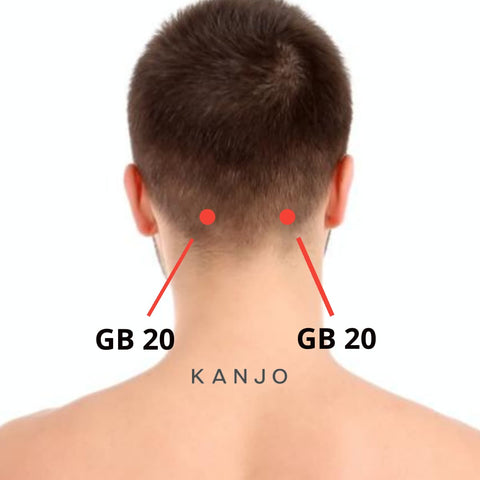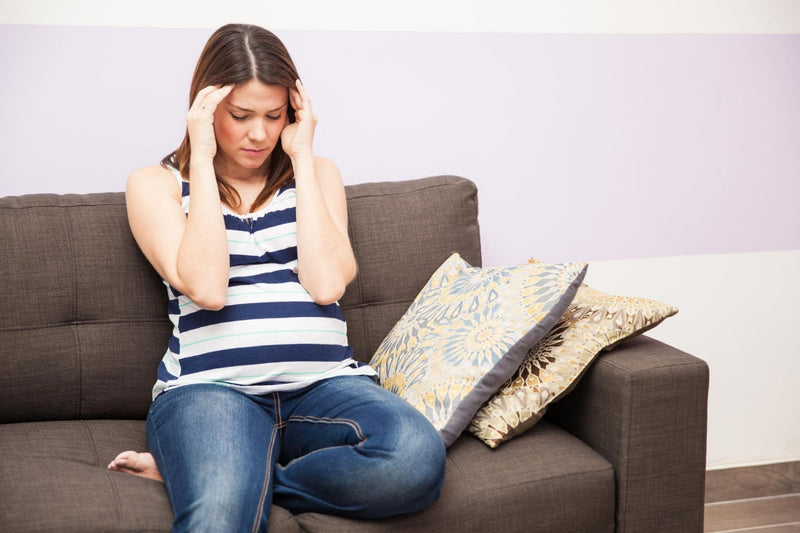Do you suffer from headaches? Are you looking for ways to use pressure points for headache relief?
This article will cover common types of headaches, how to treat them with acupressure therapy, and tips on how to prevent headaches in the first place.
How Acupressure Works for Headaches
Acupressure is a form of Traditional Chinese Medicine that uses pressure to stimulate specific pressure points on the body's surface to relieve pain. The theory behind acupressure is that when these pressure points are stimulated, energy flows through the meridian system, relieving pain.

This process is similar to acupuncture, but it does not involve inserting needles into the skin. Instead, the practitioner presses the acupressure points using their fingers, thumbs, knuckles, or elbows.
Acupressure can be effective for treating headaches because it works by stimulating the release of endorphins, which are natural painkillers that reduce feelings of discomfort. Endorphins help reduce the intensity of headaches and make people feel more relaxed.
Types of Headaches
There are over 150 types of headaches with some temporary and some more chronic headaches. These are the four most common types of headaches that people need relief from:
1. Tension Headache
Tension headaches are characterized by mild to moderate pain and are the most common type of headache. It's usually a consistent, tense pain, but not throbbing.
These headaches will come and go throughout the day, often starting after waking up or getting out of bed. They may last anywhere from a few minutes to an hour or two.
2. Migraine Headache

Migraine headaches are a common type of headache that can be a pounding pain. A migraine attack can last for 4 to 72 hours, and it may occur once or twice per month.
Symptoms include nausea, vomiting, sensitivity to light and sound, fatigue, and sometimes blurry vision problems.
3. Cluster headache
Cluster headaches are the most intense headaches with a piercing pain around or behind one of your eyes. Eye pressure can be painful and eyes can become red and watery from the headaches.
They are known as "clusters" because they happen in groups in terms of frequency and over time. The attacks can last from 15 minutes up to 3 hours at a time, and from 1 to 8 times per day. These cluster headaches can last from a couple of weeks up to 3 months.
4. Sinus Headache
Sinus headaches are caused by inflammation or infection within the sinuses. Constant pain can occur on the bridge of your nose, forehead, or cheekbones.
Other symptoms can include a runny nose, fever, mucus discharge, cough, earache, and facial swelling.
7 Pressure Points for Headache
Here are the main pressure points to perform acupressure on if you want to treat headaches.
When applying pressure to the acupressure points, keep it steady and hold for 5-10 seconds. Repeat it for a total of 5 times for one full cycle. Repeat a cycle multiple times throughout the day whenever you feel the headache coming on.
In addition to pressure point treatment, you can also massage these points with a soft, circular motion for 20 to 30 seconds.
1. Large Intestine 4 (LI 4) - Union Valley

The LI 4 acupressure points are located in the grooves between your thumb and index finger on either hand. This pressure point helps relieve headaches and migraines, along with neck pain.
The great thing about this pressure point is how easy it is to access and self-apply pressure because it's on your hand.
2. Bright Light (B 2) - Drilling Bamboo

The B 2 pressure point is probably one that you've often instinctively pressed when having a headache. It's located on the bridge of your nose where it meets your eyebrows.
This pressure point relieves headaches caused by eyestrain, migraines, and sinus headaches.
When applying pressure to these points, it's best to use both index fingers at the same time to apply pressure.
3. Gallbladder 20 (GB 20) - The Gates of Consciousness

The GB 20 acupressure point is located at the base of your skull and towards the top of your neck.
Firm pressure at the gates of consciousness pressure points will help relieve neck pain and stiffness, as well as the headaches caused by them.
4. Governor Vessel 24.5 (GV 24.5) - The Third Eye

The Third Eye acupressure point is located on your forehead between your eyebrows. It's used to relieve headaches caused by stress and tension. The point can help relieve eyestrain and sinus pressure pain too.
5. Gallbladder 21 (GB 21) - The Shoulder Well

The GB 21 points are located on both shoulders, between the base of the neck and end of the shoulders.
These points will help relieve and prevent headaches caused by neck stiffness and shoulder pain.
6. Urinary Bladder 10 (UB 10) - Heaven's Pillar

The Heaven's Pillar points are located at the base of the skull on both sides of your neck.
Stimulating these pressure points offers relief from headaches, neck stiffness, shoulder pain, and back pain.
7. Triple Energizer 3 (TE 3) - Zhong Zhu

The TE 3 pressure points are easily accessible in the grooves between your ring finger and pinky on each hand.
Applying steady pressure on these points will help to relieve headaches, neck pain, and back and shoulder pain.
Acupressure Products to Help Relieve Headaches
There are various acupressure products that can help to relieve headaches. There are products that are made specifically to apply pressure on the LI 4 pressure point between your thumb and index finger, like the Aculief wearable.
You can also get multi-purpose acupressure tools that will help relieve headaches and other pain areas, like the neck and shoulder. Relieving tensions in other areas will help reduce headaches.
These are some popular Kanjo acupressure tools that can help:

The Kanjo Memory Foam Acupressure Neck Pillow targets acupressure points on the neck and shoulders to provide pain relief.

The Kanjo Vibrating Acupressure Pillow targets acupressure points, while also vibrating to stimulate blood flow and relax muscles.

The Kanjo Acupressure Neck Pain Relief Cushion is made from a firm, flexible EVA foam that offers neck and shoulder pain relief from its knobs.
How to Avoid Headaches
Headaches can be caused by many different things, including poor posture, stress, or even just being tired. To avoid getting headaches, you should try to keep yourself healthy and relaxed.
Here are the top tips to avoid and prevent headaches:
1. Avoid Stress

Stress can cause headaches due to your body tensing up and increasing inflammation.
Find relaxation techniques to de-stress, such as meditating, listening to music, taking a bath, reading, or going for a walk.
Many of these other tips to avoid headaches are also ways to limit the stress on your body.
2. Get Enough Sleep

Sleep plays an important role in our overall health. If you're not sleeping enough, it could lead to headaches. Adults need 8 hours of sleep every night.
Try to go to bed early and wake up around the same time every day. Sleeping on a regular schedule will help prevent disruptions in your body clock and headaches.
3. Watch What You Eat

Eating well is one of the best ways to avoid headaches because some foods can cause headaches. Eating foods high in sugar can trigger headaches.
Foods and drinks that contain caffeine, including coffee, tea, chocolate, soda, and energy drinks, can also initiate headaches.
Keeping a food diary can be helpful in understanding the foods and drinks that are causing headaches. Then you can learn to limit what you consume to prevent headaches.
4. Stay Hydrated

Drinking plenty of water helps flush toxins out of your system and keeps your brain functioning properly. It also helps prevent dehydration, which can contribute to headaches.
5. Exercise Regularly

Exercise helps improve your mood and reduces stress, a common trigger of headaches. More relaxing exercises like yoga, meditation, or tai chi are better than intensive exercises that can cause physical stress.
6. Limit Screen Time

Watching too much TV or using computers for long periods of time can make you more prone to headaches. Flashing lights are a common cause of headaches, so if you have to use electronics at night, it's best in a well-lit room.
Take regular breaks when using screens to prevent eye strain and headaches. Resting your eyes is a key part of preventing headaches.
7. Limit Alcohol and Tobacco Intake

Alcohol and tobacco can increase your chance of headaches. Drinking alcohol can affect how quickly your body metabolizes what you've ingested and will dehydrate your body.
Smoking increases the amount of nicotine in your bloodstream, which can affect your nervous system and lead to headaches.
Other Ways to Get Rid of Headaches
There are a number of other ways to get rid of headaches.
Over-The-Counter (OTC) Medicine
OTC medications such as ibuprofen and acetaminophen (Tylenol) can help reduce pain and inflammation.
These medicines work by blocking certain chemicals from reaching receptors in your brain. They don't cure headaches, but they do provide temporary relief.
Caffeine
Even though caffeine can trigger some headaches, it can also help as it reduces inflammation. Caffeine is even an ingredient in some common pain relievers.
A cup of coffee or tea may help relieve tension and ease headache symptoms.
Ice and Hot Patches
Ice and heat can both help with headaches. Ice packs can cool down a painful area and reduce swelling. Heat therapy works by increasing blood flow to the affected area and relaxing muscle tension.
Which to use is more of a personal preference. Many people will choose heat for a tension headache and ice for a migraine. Try an ice pack and if that doesn't work, try a heating pad, and vice versa.
Acupressure Points for Headaches Final Thoughts
Acupressure is one of the best ways to quickly treat headaches. Using your own fingers to apply pressure on acupuncture points is convenient and easy to learn.
You can practice acupressure anywhere, whether sitting at home or at work, to relax muscles and release tension.
Acupressure for Headaches FAQ
How should I sleep to avoid tension headaches?
Sleeping on your sides or back will help avoid tension headaches. These sleep positions will keep your spine in its natural alignment and prevent muscle tension in your back and neck that can lead to headaches.
What kind of headache is behind one eye?
If you have a headache that's behind one eye, it's usually a cluster headache. It can be a piercing pain that can lead to red and watery eyes. The pain will occur in clusters up to eight times a day for 15 minutes to 3 hours each time.
Is it better to sit up or lay down with a headache?
Laying down and taking a nap can help relieve a headache. If you're feeling nauseous, lightheaded, or dizzy, laying down can help. Sleep is one of the best things you can do for headache relief.
Could my pillow be causing headaches?
Pillows that cause awkward sleeping positions can lead to headaches from neck muscle tension. A good pillow will support your head while keeping your neck straight.
What does a dehydration headache feel like?
A dehydration headache varies from person to person. The pain can range from a mild, dull headache to severe, sharp pains. Dehydration headaches can be located in one spot of your head or all over.
Sources:
- Healthline: https://www.healthline.com/health/pressure-points-for-headaches
- WebMD: https://www.webmd.com/migraines-headaches/migraines-headaches-basics
- Cleveland Clinic: https://my.clevelandclinic.org/health/diseases/9639-headaches
- Acufinder: https://www.acufinder.com
- Healthline: https://www.healthline.com/health/migraine/how-to-avoid-one-before-it-happens
- Mayo Clinic: https://www.mayoclinic.org/diseases-conditions/chronic-daily-headaches/symptoms-causes/syc-20370891
